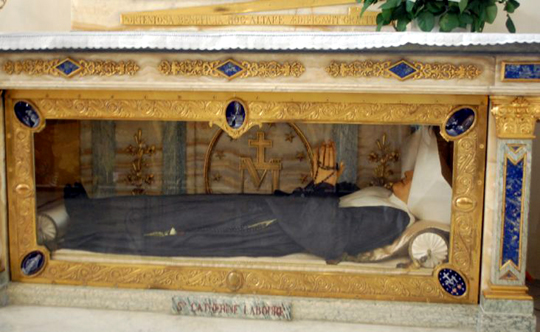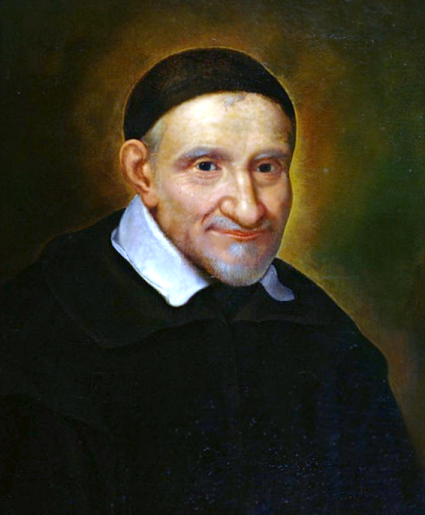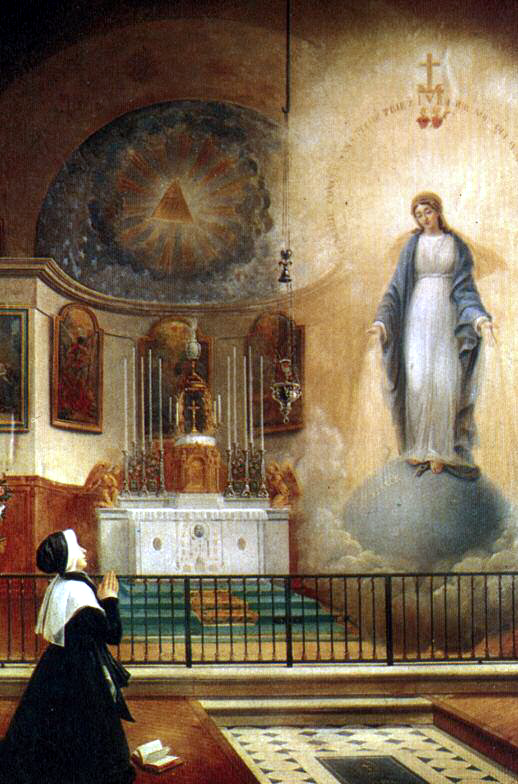The Miraculous Medal: Medal of Many Graces
Armando Santos
The medal of Our Lady of Graces, more commonly known as the Miraculous Medal, is undoubtedly the most widespread medal of all times. It originated in France in 1830, having been revealed directly by Our Lady to Saint Catherine Labouré while yet a young religious.
The Miraculous Medal is oval. On one of the faces Our Lady is depicted with her arms extended. The rays of light symbolize the graces with which she showers the faithful. At the same time, she crushes the head of the infernal serpent with her virginal feet. Framing the Virgin around the edge is the prayer: “Oh Mary conceived without sin, pray for us who have recourse to thee.”
On the other face is the letter “M” with a cross on top. Below are the Sacred Hearts of Jesus and Mary. Twelve stars encircle the medal, reminding us of the famous words of the Apocalypse: “A woman clothed with the sun, and the moon under her feet, and on her head a crown of twelve stars” (Apoc. 12:1).
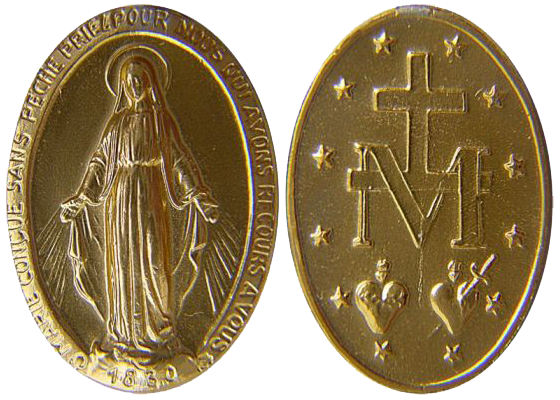
Childhood and Education of Saint Catherine Labouré to Whom Our Lady Revealed the Miraculous Medal
Saint Catherine Labouré was born in 1806 in Fain-lès-Moutiers in the French Province of Burgundy. Her father, Pierre Labouré, owned a rural property that he worked himself. Her mother, Magdalène Gontard, belonged to a distinguished and cultured family related to the nobility of the region.
Catherine was only nine years old when her mother died. Desolate, the girl climbed onto a piece of furniture and embraced a statue of Our Lady. Weeping, she asked the Virgin to replace her mother whom she had just lost: “From now on, you will be my Mother.”
Her religious vocation seems to have its origins in her early childhood and reaffirmed itself on the occasion of a mysterious dream she had when about eighteen years old. She dreamt that she was in the little church of Fain-lès-Moutiers and that an elderly priest, with an impressive gaze, was celebrating Mass. At the end of the Mass, the priest motioned her to approach. Afraid, she hesitated, but was fascinated by the extraordinary brilliance of his gaze. Shortly afterwards, in the same dream, she once again came across the old priest who said: “My daughter, you flee from me now, but one day you will seek me. God has designs for you, never forget this.”
At the time, Catherine did not understand the dream. Only some time later when she saw a picture of Saint Vincent de Paul at the house of the Daughters of Charity in Châtillon-sur-Seine, where she went to study, did she recognize the mysterious personage of her dream. She then understood that the founder of the Daughters of Charity was calling her to be his spiritual daughter.
Saint Catherine’s earthly father put all sorts of obstacles to her entering the religious life. After a long struggle, and only when she was twenty-three years old, did she finally obtain permission to enter the Daughters of Saint Vincent de Paul in Châtillon-sur-Seine. Three months later in April of 1830, she was transferred to another house of the congregation on the Rue du Bac in Paris.
Shortly after Catherine’s arrival at Rue du Bac, the body of Saint Vincent de Paul—who had died 170 years earlier—was solemnly transferred to the Chapel of Saint-Lazare from the Notre Dame Cathedral in a magnificent silver reliquary. His body was incredibly well preserved, as if he had died just a short while before.
The following week, Catherine had the first of her supernatural visions.
She narrates:
The heart of Saint Vincent appeared to me under three different forms, for three consecutive days. First it was light in color, flesh color, bespeaking peace, calm, innocence and concord. Next it was red as fire, as if to signify the charity that, by enkindling all hearts, should renew the entire community and enable it to spread to the remotest parts of the earth. Finally, I saw it as dark red, which caused me great sadness that seemed to me nearly insurmountable and, I know not why, linked to a change in the government.
With docility and confidence, Catherine told her confessor, Fr. Jean-Marie Aladel, about her visions. But he, fearing they were diabolical illusions or the effect of an over-excited imagination, was adamant and advised her not to take them seriously.
Vision of the Blessed Sacrament and the First Apparition of Our Lady
During her whole novitiate, Catherine was privileged to see Our Lord in the Blessed Sacrament “except when I doubted.” In other words, when she, in order to be faithful to her confessor, tried to resist the supposed illusion.
During one of these visions, “Our Lord appeared to me in the Blessed Sacrament as a king with a cross on His breast. At the moment of the Gospel, it seemed to me that the cross slipped down to His feet. It seemed that Our Lord was bereft of all His vestments as they fell to the ground. Then I had the darkest and saddest thoughts: the earthly king would be dethroned and despoiled of his royal ornaments.”
This vision took place on Trinity Sunday on June 6, 1830, seven weeks before the political agitation that culminated in the dethroning of King Charles X. Illuminated by this supernatural vision, young Catherine understood that the monarch would soon lose his crown and that this would be a victory of the forces of evil in France. She deemed it necessary to warn her confessor Father Aladel, who once again took the warning lightly.
On the night of July 18, 1830, the feast of Saint Vincent de Paul, Saint Catherine saw Our Lady for the first time. It was her Guardian Angel, under the guise of a little boy, who took her to the Virgin. Let us once again read her own account which is impressive for its simplicity and unction:
The novices had received a piece of Saint Vincent’s linen surplice. I cut mine in half, swallowed one piece, and then went to sleep with the thought that he would obtain for me the grace to see the Most Holy Virgin.
At eleven thirty I awoke to the sound of my name being called: “Sister Labouré! Sister Labouré!” I drew aside the curtain and saw a little boy of about four or five years of age, dressed in white and surrounded by a radiant halo, who said: “Come to the chapel. Our Lady is there waiting for you.”
I dressed in haste and went to the side of the little boy, who had remained standing at the head of my bed. He accompanied me, keeping to my left side. All the places we went through were illuminated, which greatly surprised me. However, I was even more surprised at the door of the chapel, for it opened at once when the boy just barely touched it with the tip of his finger. And my surprise was even more complete when I saw that all the candles were alight, reminding me of the midnight Mass.
However, I did not see the Most Holy Virgin. The little boy led me to the presbytery next to the Spiritual Director’s armchair. I knelt there, while the boy remained standing the whole time.… Finally, the moment came. The boy advised me, “The Holy Virgin is coming; here she is.”
I then heard something like the rustling of a silk dress, from beside the pulpit near the picture of Saint Joseph and ceasing over the steps of the altar on the Gospel side, on a chair like that of Saint Ann. At that moment, seeing the Most Holy Virgin, I rushed forward, knelt before her, and placed my hands on her knees. It was the sweetest moment of my life, but I cannot express all that I felt.
In another manuscript, Saint Catherine Labouré was more explicit and revealed, at least in part, what she heard from the Most Holy Virgin:
My daughter, the good God wants to give you a mission. You will suffer much, but you will overcome those sufferings by considering that you will do so for the glory of God.… You will be contradicted, but you will receive grace. Do not fear. Tell everything [to your confessor] with confidence and simplicity. Have confidence, do not fear.
A little later, Our Lady began to speak of future events that soon took place:
The times are very evil. Great calamities will befall France. The throne will be overthrown. The whole world will be disturbed with evils of all sorts (the Most Holy Virgin was very sad when saying this). But come to the foot of this altar. Here graces will be poured out over all persons, great or small, who request them with confidence and devotion.
Next Our Lady spoke about the community of the Daughters of Charity to which Saint Catherine belonged, and about the Lazarist priests, also founded by Saint Vincent de Paul:
My daughter, I am pleased to shower this community with graces, for I love it very much. But I am saddened to see the great abuses that exist regarding regularity. The Rule is not kept. There has been too much relaxation in both communities. Relate this to the person in charge of you, even though he is not yet your superior. Later, when he is given charge of the community, he should do everything in his power to restore the Rule again. Tell him that I say he must guard against bad reading material, against the wasting of time, and against useless visits.
She then spoke anew of the terrible events that would happen in the more distant future. Forty years before their time, she predicted the agitation of the Paris Commune and the assassination of the Archbishop of Paris. And she promised her special protection for the sons and daughters of Saint Vincent de Paul during those tragic times:
You will know my visit and the protection of God and Saint Vincent over the two communities. Have confidence! Do not lose courage. I will be with you. But this will not happen with other congregations, among whom there will be many victims. (When saying this, the Most Holy Virgin had tears in her eyes.) There will be victims among the clergy of Paris: the Archbishop himself will die. (At these words, she again wept.)
My daughter, the Cross will be despised and thrown down. Blood will flow. The side of Our Lord will be reopened. The streets will flow with blood. The Archbishop will be deprived of his vestments. (Here the Most Holy Virgin could not speak anymore; suffering appeared on her face.) My daughter, the whole world will be in suffering.
At these words Saint Catherine wondered when this would happen. And she understood very well: in forty years.
As always, Catherine faithfully told everything to her confessor. Once again he was severe, saying that this was “pure fantasy” and reprimanded the novice. But the incredulous confessor could not help but be struck with terror, because one week later the prophecies began to be fulfilled.
By July 26, news arrived of mayhem in the streets and within a few days King Charles X had been deposed. Besides being liberal, the revolution of 1830 was also violently anti-clerical. But the Lazarists and the Daughters of Saint Vincent de Paul went through this critical period unharmed just as Our Lady had promised.
During the Second Apparition, Our Lady Reveals the Miraculous Medal
Four months later, on November 27, 1830, Our Lady appeared again to Saint Catherine. She taught her the devotion to the medal, which, because of its prodigies, Catholics would call the Miraculous Medal. Let us once again listen to the words of the saint:
I saw the Most Holy Virgin; she was at the level of the picture of Saint Joseph. She was of medium height, standing and dressed in a silk robe, as white as the glow of the dawn…She wore a white veil on her head that extended to her feet and covered her entirely. Through this veil, I saw her hair parted in the middle and held by a piece of lace of about an inch in width. Her face was uncovered, totally uncovered. She stood on a half sphere…and had in her hands a sphere of gold that represented the globe. Her hands were raised to the height of her waist in a very natural way and her eyes looked up to Heaven…Her face was extremely beautiful. I would not know how to describe it…And then, suddenly, I saw rings appear on her fingers, covered with stones, some more beautiful than others, some larger and some smaller, and shedding rays, each more beautiful than the other. The most beautiful rays came from the largest stones, always extending downwards, filling the lower area. I could no longer see her feet…At this moment, as I was contemplating her, the Most Holy Virgin lowered her eyes and looked at me. A voice spoke within me:
“The sphere you see represents the whole world, particularly France, and everyone in it.…”
Here I do not know how to express what I felt and saw, the beauty, the brilliance, the splendid rays…
“The rays of light from my hands are the graces I shower on those who request them.” I understood how pleasing it is to pray to the Most Holy Virgin and how generous she is to those who pray to her, how many graces she grants to those who pray for them, the joy she feels granting them.
A sort of oval frame formed around the Most Holy Virgin, with the following words on the upper part: “O Mary conceived without sin, pray for us who have recourse to thee,” written in gold letters. The inscription, in a semicircle, began at the right hand passing over the head and ended at the left hand.
Then a voice said: “Have a medal struck upon this model. Everyone who wears it, when it is blessed, will receive great graces especially if they wear it around their neck. The graces will be abundant for those who wear it with confidence.”
The following month, Saint Catherine saw Our Lady once again:
“It is impossible to express what I understood at the moment when the Most Holy Virgin offered the globe to Our Lord,” the seer wrote. And then added, “As I was enraptured in the contemplation of the Most Holy Virgin, a voice resounded in the depth of my heart: ‘These rays symbolize the graces the Most Holy Virgin obtains for those people who ask for them.’”
Saint Catherine noticed that no rays were issuing from some of the stones on the rings. A voice enlightened her: “The stones from which nothing issues are graces men forget to ask from me.”
The First Medals are Struck and Stupendous Prodigies Take Place
Saint Catherine’s confessor, however, continued to be incredulous. He considered her to be a visionary not to be taken seriously. For more than a year, Saint Catherine indefatigably insisted with the priest that medals be struck as Our Lady had determined. But he inflexibly continued to resist.
One day Father Aladel was asked to accompany his superior to an audience with the Archbishop of Paris, Archbishop Quélan. Taking advantage of the opportunity, he informed the Prelate what was happening at Rue du Bac without revealing the name of the visionary. This audience took place in January of 1832, ending a long period of affliction for the holy religious.
The Archbishop, contrary to Father Aladel, immediately endorsed the striking of the medal. Encouraged, Father Aladel changed his attitude and four months later, in May, placed an order for 20,000 medals with Vachette House.
As the first medals were being made, a terrible epidemic of cholera, coming from Eastern Europe, struck Paris.
The disease first appeared on March 26, 1832, and carried on until the middle of the year. By April 1, seventy-nine people had died; on the 2nd, 168; on the 3rd, 216. In this way the death toll rose until reaching 861 on April 9. In total, the official records say that 18,400 people died. In reality, the number was much greater because the official statistics and the media purposely under-estimated the numbers to avoid even greater panic.
On June 30, the first 1,500 medals were delivered by Vachette House and the Daughters of Charity began distributing them among those afflicted. The epidemic receded immediately and a series of prodigies began that very quickly made the Miraculous Medal world famous.
The Archbishop, who had received some of the first medals, immediately obtained an extraordinary grace through them and became an enthusiastic promoter and protector of the new devotion. Pope Gregory XVI also received a package of medals and began distributing them to people who visited him.
By 1836, more than fifteen million medals had been struck and distributed throughout the world. In 1842, this figure reached 100 million. From the furthest corners of the earth arrived reports of extraordinary graces obtained through the medal: cures, conversions—like that of Alphonse Ratisbonne— protection against imminent dangers, and other favors, too numerous to mention here.
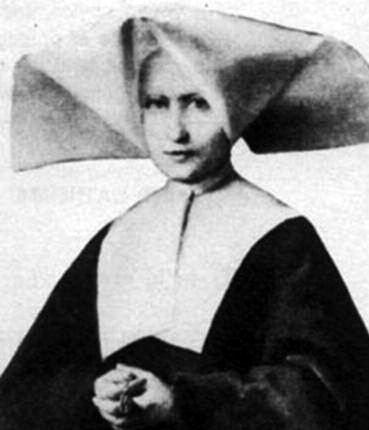
In 1830, Our Lady appeared to Saint Catherine Labouré and gave her the mission of having the Miraculous Medal struck and distributed throughout the world.
Saint Catherine lived a “hidden” life, a life for God alone. Her daily tasks were sanctified by her fidelity to her vocation even though she never worked a miracle nor did she accomplish feats of unusual grandeur.
She died on December 31, 1876 at the age of 70. In 1895, her cause for Beatification was introduced in Rome. Exhumed in 1933, her body was judged to be incorrupt by the Church, and it now lies in a glass coffin at the side altar of the Chapel of Our Lady of the Miraculous Medal, Paris, one of the spots where the Blessed Mother appeared to her. She was beatified on May 28, 1933. On July 27, 1947, she was canonized by Pope Pius XII.
